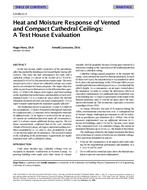Description
In the last decade, public awareness of the greenhouse effect has pushed the building sector toward higher energy efficiencies. This move has had consequences for roofs with a cathedral ceiling. A U-factor in the vicinity of 0.2 W/(m2·K) instead of 0.6 W/(m2·K) became the new target value. The move toward such a low U-factor for cathedral ceilings was evaluated in an extended test house program. The major objective of the research was to find answers to the following three questions: (1) What is the impact of air ingress and wind washing on the hygrothermal performance and durability of such well-insulated roofs? (2) Is a vented air space above the thermal insulation needed to prevent concealed condensation? (3) Is a vapor retarder underneath the insulation equally efficient? The traditional answer to questions (2) and (3) is built on five assumptions: (1) heat is transported through all materials by conduction only, (2) moisture moves through the materials by diffusion only, (3) air ingress is restricted to the air space, (4) outside air ventilation functions under all circumstances, and (5) it always means additional drying capacity. The test house measurements confirmed that in the cool, maritime climate of Western Europe, air ingress and wind washing overthrow assumptions (1), (2), and (3). Also, assumptions (4) and (5) are not true under all circumstances. The research resulted in the redrafting of the performance requirements for highly insulated roofs with a cathedral ceiling.
Units: Dual
Citation: Symposium, ASHRAE Transactions, vol. 105, pt. 1
Product Details
- Published:
- 1999
- Number of Pages:
- 14
- File Size:
- 1 file , 1.5 MB
- Product Code(s):
- D-7597




